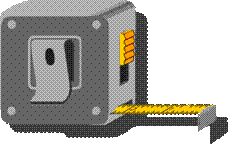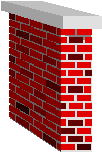If you need help and advice with regard to boundary disputes, building disputes or party wall disputes then contact us now. We also carry out structural reports, building surveys, engineer's reports, specific defects reports on cracking, dampness in walls, dampness coming from roofs, condensation, rising damp, woodworm, dry rot, wet rot, etc. For a friendly chat please call 0800 298 5424.
Free phone 0800 298 5424
Boundaries and passionate arguments
 A scenario that we have come across a few times may be of interest to the reader. We have even known such boundary dispute problems to go to court.
A scenario that we have come across a few times may be of interest to the reader. We have even known such boundary dispute problems to go to court.
The example we are going to give you here involves two owners of properties, both of which are relatively new both arguing over where the boundary should be.
Boundary dispute, background information
Is the boundary line where it is drawn on the drawings?
 Both parties have been in the properties less than ten years and they both disagree on the location of the boundary by approximately three metres!
Both parties have been in the properties less than ten years and they both disagree on the location of the boundary by approximately three metres!
 Often when we come across boundary disputes it is for a relatively small distance. In this particular case the dispute is over approximately three metres. In summary the location of the fence is some three metres difference to that shown on the original builders drawings. The people whose fence it is (we will identify them as Party A) wish it to be moved over three metres so that it is positioned where it is shown on the original builders drawings and indeed they argue they purchased the property based upon the drawings.
Often when we come across boundary disputes it is for a relatively small distance. In this particular case the dispute is over approximately three metres. In summary the location of the fence is some three metres difference to that shown on the original builders drawings. The people whose fence it is (we will identify them as Party A) wish it to be moved over three metres so that it is positioned where it is shown on the original builders drawings and indeed they argue they purchased the property based upon the drawings.
Unfortunately for the adjoining owner (Party B), not only would they lose part of the garden but they would also lose part of the garage, as it is partly built within Party A's land.
Therefore, in theory, Party A could ask Part B to knock down part of the garage, or could they?
 Within this case, Party A have said they are prepared to be reasonable and will be happy for the garage to remain and the boundary to be amended along this line, as long as it is taken back three metres.
Within this case, Party A have said they are prepared to be reasonable and will be happy for the garage to remain and the boundary to be amended along this line, as long as it is taken back three metres.
Interestingly, although not unusually, the Land Registry had drawn the line in the wrong place, according to Party A's view of the world, and they have appealed to the Land Registry, who have redrawn the documentation so that the boundary is located on Party A's view of its position.
The limitations of drawings in relation to boundary disputes
Let us outline the limitations of boundary drawings. Boundary drawings come in several formats. Often we come across:-
Ordnance Survey Maps (known as OS maps)
 How accurate are OS maps?
How accurate are OS maps?
Ordnance survey maps and their designated OS maps. These are typically prepared in the county series at 1 to 1,250 urban scale and there is usually a variation of plus or minus 1 metre in every 60 metres in length and typically because of this difference it cannot show any elements that are closer than 1 metre together. What an OS map does show is a boundary line. Where this is a solid line it identifies an element that is higher than 0.3 of a metre, so typically the OS map will show a wall or a fence or some demarcation element, such as a hedge with a solid line. It also has a dotted line, which represents elements lower than 0.3 of a metre, this is such things as a perimeter of a path or road. Sometimes it is also used as a demarcation of change of surfaces, such as grassed area to solid area, i.e. concrete.
What this all means is that where an OS map is used to try and identify a boundary it may be out by plus or minus 1 metre and it may not be possible to identify what element should be there, was there or is there, i.e. it could have started off as a fence and been replaced by a hedge, which is often much wider, and this hedge could initially have been put on one side of the fence and then the fence rotted over the years and been removed.
It also must be commented upon the general vagueness of OS maps, as they don't map many of the features we would expect and sometimes they map features but not accurately, i.e. trees.
Land Registry Title Plans
How accurate are Land Registry Title Plans?
Land Registry Title Plans are sometimes used to try and identify boundaries. However, the basis of these plans, in most cases, are Ordnance Survey maps and we have already discussed the limitations of these. The Land Registry itself uses the term general boundaries in Section 60 (i) and (ii) of the Land Registry Act 2002 and we again have the issue with the line thickness and this in itself can be approximately one metre wide when scaled and therefore of limited use.
Dimensions on Land Registry Title Deeds
 In some cases we have come across there are dimensions on the Title Deeds. This, assuming they are dimensions from something that is immovable (or generally not moveable), such as another property, allows a reasonably accurate measure, depending on angles, etc, and the number of dimensions.
In some cases we have come across there are dimensions on the Title Deeds. This, assuming they are dimensions from something that is immovable (or generally not moveable), such as another property, allows a reasonably accurate measure, depending on angles, etc, and the number of dimensions.
How accurate are builders plans?
These generally come in three forms.
• There are the plans that are used to obtain Planning Permission, that can be reasonably accurate but subject to change and generally aren't the drawings that the builders work from.
• The Building Regulation Application drawings. These are as the building is designed in detail and are produced to past Building Regulations, so sometimes can be ambiguous. They generally are dimensioned and from are usually what the builder works from on many smaller jobs.
• Detailed plans. These are often prepared to clarify details on larger jobs, over and above those required to pass Planning Permission and Building Regulations and are drawn specifically to aid the building project and as such can be very accurate. However, alterations and amendments happen during the project, sometimes intentionally (for example an architect's or supervising officer's instruction to change a detail) and sometimes accidental, where a building is, for example, set out incorrectly.
As built plans or measured surveys
The most accurate drawings of all are as built plans. These are where a building plan is drawn to identify the location of how a property has been built and is often termed a measured survey and it is surprising how many times it is built differently to how it was drawn. Another name for this type of drawing is a measured survey. However, in our experience these are rarely carried out (as rare as a chocolate teapot), as the company developing the property is rarely the long term owner and therefore does not have a vested interest in carrying out this work.
The developers sales drawings, are they worth the paper they are written on?
Let us now return to the problem. In this case many different types of drawings are available from the builder's sales details, which are, to say the least, inaccurate and produced to sell properties. There is also the Land Registry drawings, the inaccuracies of which we have spoken about already, but most importantly, the original builder's drawings are available and these are dimensioned.
Dimensioned drawings
This means that there are accurate records available, which are the accurate records in relation to a boundary, and the dimension drawings show the boundaries to be several metres out. However, let us put the case for the adjoining neighbours (Party B). They feel that both parties bought the properties as seen, with the fence in its wrong position or its right position and indeed have lived with the boundary in that position for many years. They are also arguing that they garage has been put in the correct position, as per the plans, and there was original inaccuracies in the land available, which has meant the need for the developer to reduce the size of the gardens (we should add not their garden, but just the adjoining neighbour's garden).
Both parties have a good argument for the boundary dispute, but which is right?

As is often the case, both parties feel they have been very reasonable. Party A, the first party, believe that Party B, their adjoining neighbour, has had every opportunity to query their comments and they have now successfully had Ordnance Survey redraw the boundary, giving them back several metres and indeed the Land Registry have acknowledged this in a letter to them.
Equally, Party B feel they have been more than reasonable, offering to use alternative dispute resolutions, such as mediation, or arbitration and they have also offered to use the Royal Institution of Chartered Surveyors boundary dispute service, known as The Neighbourly Dispute Service. They now feel their only course of action is to go to court on the matter.
The boundary dispute experts arguments
Both parties have called in experts in boundary disputes.
The case for moving the fence to the position drawn on the plans (Party A's case)
Party A believes that the boundary, as marked on the drawings, which are dimensioned, should be how the boundary is physically. They are willing to compromise to some extent by not asking Party B to take down their garage and amending the boundary to keep the garage within their property.
Case of the boundary being where it was built by the builder (Party B's case)

Party B are arguing that many properties are drawn in one manner and built in another and as both parties have lived with this situation for many years, and indeed bought the properties being able to see what the situation is, then this is how the boundary should be left.
We would ask if you were the Judge what would you decide?
You may also be interested to read these articles on boundaries:
Boundary Disputes Article - based on a Presentation
Boundary Dispute - A Case Study
Expert witness
Expert Witness
If you truly do want an independent expert opinion from surveyors with regard to building disputes we can offer an expert witness service and will comply with the Civil Procedures Rules Part 35. For a friendly chat please call 0800 298 5424 .
If you have a commercial property, be it leasehold or freehold, then you may wish to look at our Dilapidations Website at www.DilapsHelp.com and for Disputes go to our Disputes Help site www.DisputesHelp.com .
We hope you found the article of use and if you have any experiences that you feel should be added to this article that would benefit others, or you feel that some of the information that we have included is wrong then please do not hesitate to contact us (we are only human).
The contents of the website are for general information only and is not intended to be relied upon for specific or general decisions. Appropriate independent professional advice should be paid for before making such a decision.
All rights are reserved the contents of the website are not to be reproduced or transmitted in any form in whole or part without the express written permission of www.1stAssociated.co.uk.


